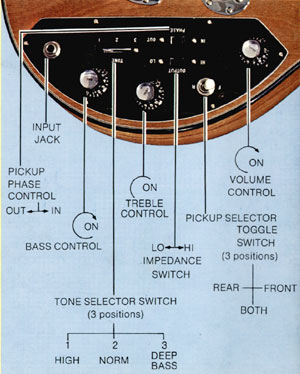Have a closer look at this 1972 Triumph
Les Paul also narrated a protional flexi-disc for the Les Paul Recording Guitar and Triumph bass - see the 1971 Gibson Low Impedance catalog.
Other changes from it's predecessor were cosmetic; all controls were situated on the front mounted control panel, rather than onto the wood itself. The standard finish was natural mahogany, with white becoming available from 1975. This bass also featured the split diamond inlays on the headstock, and block position markers (replacing dots) on the neck.
Les Paul Triumph specifications:
- Honduras mahogany body with dark binding
- Laminated mahogany set neck, with rosewood fretboard
- Natural mahogany or white finishes
- 30 1/2 inch scale (actually three eighths of an inch). 24 frets
- Two low impedance humbucking pickups
- Hi or Low immpedance modes
- Body size length: 17 1/4" width: 12 3/4" depth 2"
- Width at nut 1 1/2"

Les Paul Triumph controls
Bass, Treble and Volume Self explanetory. The bass and treble have a very wide range.
Tone Selector Three settings: hi, normal and deep bass.
Phase Control Only works when both pickups are selected
Impedance Selector Hi for live use or Low for studio use (or live use with a Low-Impedance amplifier)
The Les Paul Triumph was capable of making a wide range of sounds; deep bass, clear midtones, and bright treble - plus a whole lot more in between. Check out a 1972 LP Triumph, and hear some more sound clips.
Rarities
Prototypes at least one single pickup Triumph exists. If you are aware of another bass like this, please comment
Kalamazoo Or Nashville Plant, USA
in 1976
Production Number: 139449